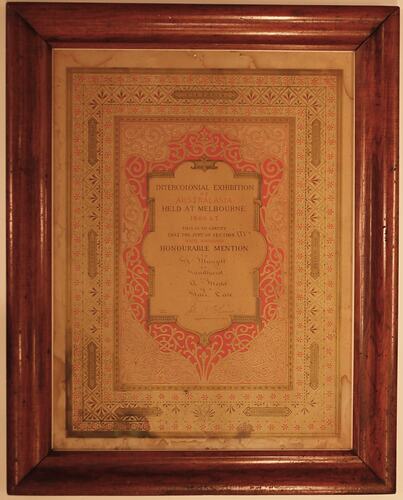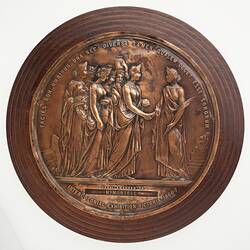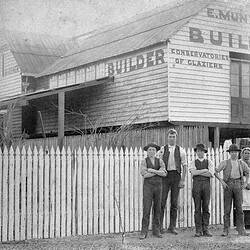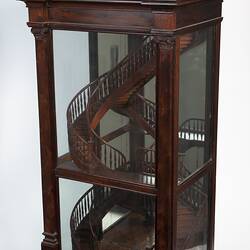The Munzel Collection consists of a double spiral staircase model, a medallion and framed certificate from the 1866 Intercolonial Exhibition, and two photographs of the Munzel family and workshop.
The double spiral staircase model was crafted by Heinrich Munzel from Brazilwood. It was made in Pernambuco, Brazil between 1835 and 1850. It is probable that the model was made soon after Munzel's arrival in Brazil in 1835, as it would have been used by him to establish his name and demonstrate his skills as a master craftsman.
Heinrich Munzel brought this model staircase with him to Australia in 1850, and in 1866 entered it in the Sandhurst Division of the Intercolonial Exhibition held in Melbourne. The Inter-Colonial Exhibition was seen as 'a temple of industry' and celebrated the wealth created from Victoria's goldfields and the colony's growing confidence in its manufacturing and industrial future. It was held in a new exhibition area at the rear of Melbourne's Public Library from 23 October 1866 until 23 February 1867. Munzel's staircase model was one of nearly 3,000 exhibits on display from every Australian colony and New Zealand, New Caledonia, Mauritius and the Dutch East Indies. The exhibition was a popular and critical success attracting almost 100,000 visitors.
Munzel's Staircase Model was awarded an Honourable Mention at the Exhibition, and Munzel was presented with a medallion and certificate of recognition. According to family sources, the brass medallion was used by later generations of Munzel women as a trivet for laundering irons.
The model, medallion and certificate were handed down through generations of the Munzel family. They were purchased in 2010 by Museum Victoria from Glen Parsons, a descendent of Heinrich Munzel, who had rescued it from a woodshed and restored the staircase in the 1970s.
This collection intersects with a number of important historical narratives and collecting areas: the process and experience of German migration to Victoria, history of the goldfields, the 1866 Intercolonial Exhibition, the use of rare native timbers in design and construction, and Victorian goldfields architecture.
The collection has a strong provenance and is supported by photographs in Museum Victoria's collection which show Henry Munzel and his family standing in front of his home and workshop in Bendigo. This staircase also has strong connections with the built heritage of Bendigo.
The Munzel Collection is an important addition to the Museum's collection relating to the 1866 Intercolonial Exhibition. Museum Victoria holds over 100 items that document this Intercolonial Exhibition, but the Munzel collection is the only example of an exhibit from the 1866 exhibition which includes the certificate and medallion, and supporting provenance.
While the model staircase was made in Brazil, its grandeur reflected the aspirations of a young, wealthy colony, and its progress toward refinement and self sufficiency. The award received by Henry Munzel, was a celebration of the master craftsmen who settled in Australia, and whose skills would help create and give form to a prosperous Victoria.
References
The Age, 24 Oct 1866, cited in E.C. Harris, Hons thesis 2005
More Information
-
Keywords
Exhibitions: Melbourne Intercolonial, Australasian, 1866-1867, Immigration, German Immigration, German Communities, Gold Rushes, Goldfields, Woodworking
-
Authors
-
Article types





